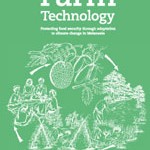Download PDF (6MB)Farm technology FINAL sm
People from Melanesia heavily rely on their land for their livelihoods. They depend on their environment for food and income from cash crops, for clean water, fertile soil, forests for building materials, medicine and for hunting.
Compared to other countries, most Melanesians have very small ‘carbon footprints’ having contributed very little to global warming and climate change. Unfortunately they will be among those most vulnerable to the impacts of climate change due to their high dependency on their immediate environment and close proximity to the coast. While the challenges ahead are enormous, farmers’ innovations can make a great starting point for strengthening food security in Melanesia.
How to use this guide
This guide aims to provide a range of traditional and innovative technologies that make a positive contribution to strengthening food security in Melanesia in response to climate change. It aims to encourage rural farmers in Papua New Guinea, the Solomon Islands and Vanuatu to think about, and start to prepare for, the impacts of climate change in their communities. It is written for farmers and field or extension workers, teachers and others who work with farmers.
It is part of an innovative program that seeks to strengthen food security as an adaptive measure to the effects of climate change in Melanesia. It has been developed by Live & Learn Environmental Education through funding from the Australian Agency for International Development (AusAID).
The guide can be used on its own, or during discussions and workshops. It is divided into six chapters:
1. Introduction to climate change
2. Alternatives to shifting cultivation
3. Agro-forestry
4. Soil fertility
5. Emergency or food security gardens
6. Low islands, atolls and small areas of land
Many of the authors are Planting Material Network members and kastom gaden staff. Kastom Gaden helped produce the manual by organising the lead farmers and nominating technologies to include in the manual. The facilitation was carried out by KGA co-founder Tony Jansen who authored and edited the manual for Live and Learn Environmental Education.


No Comments